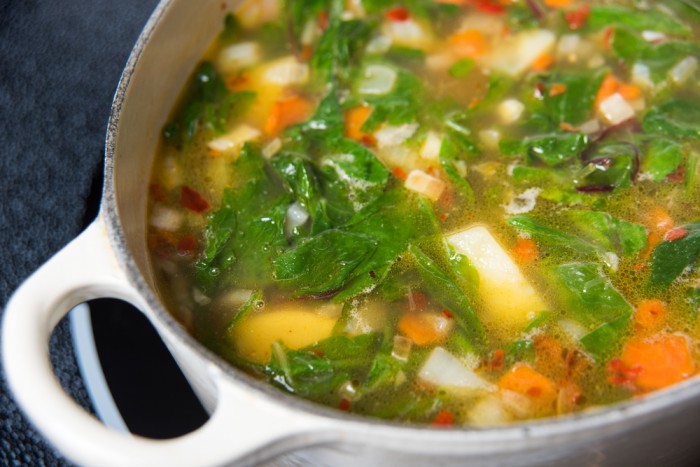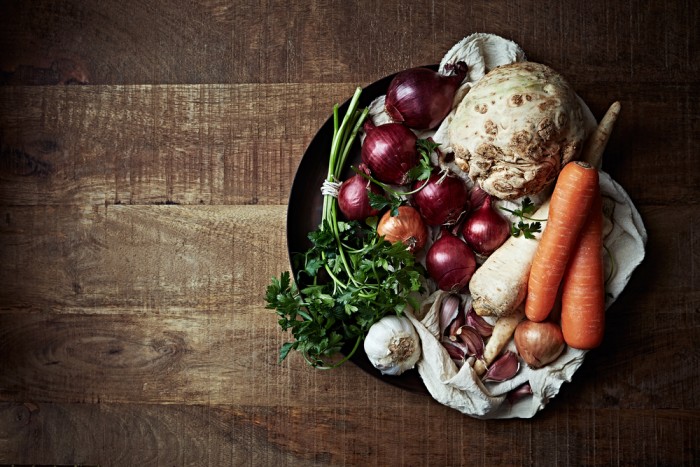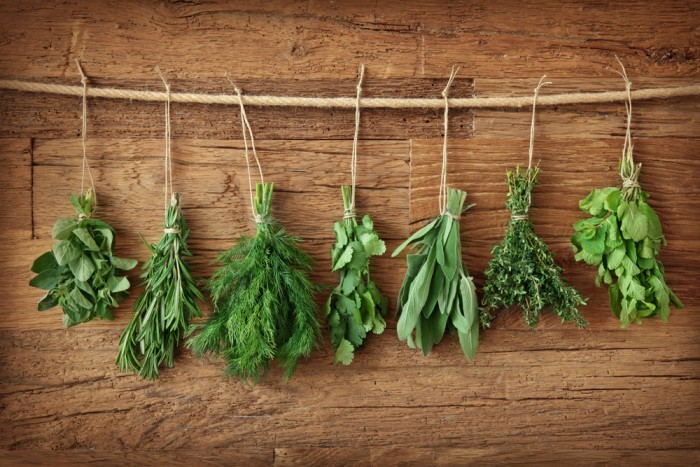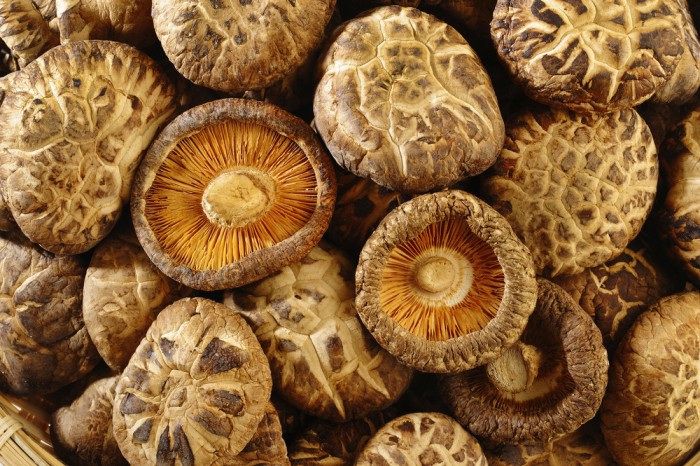
I don’t know about you, but bone broth gets me excited (yes, I’m kind of weird that way).
It feels healing, full of history, and intrinsically sustainable: when I make it, I use what otherwise might be food waste to create something powerful. Whether you’re a seasoned broth brewer or a total newbie, our prep, cooking, and recipe tips can help you make a tasty and nourishing broth.
We asked herbalist and author Briana Wiles to give us the skinny on brewing an easy and nutritious broth. She told us to toss in plenty of medicinal herbs, mushrooms, and sea vegetables to add calcium, vitamins, and minerals to the soup. Let’s tap into Briana’s knowledge and look deeper into which herbs to use and how to integrate them into your broth.
Briana Wiles is the author of Mountain States Foraging and the founder of Rooted Apothecary, where she’s been selling organic and wildcrafted herbal products made in small batches since 2011. You can find Rooted Apothecary at a few farmers markets and fairs, and through an online store.

Briana explains her motivation as an herbalist: “I want people to obtain knowledge about plants and to never forget it, passing it down through generations.” She loves what plants have taught her and feels that mainstream society has moved too far away from understanding and using plants for healing. She respects the benefits of Western medicine and its incredible life-saving technologies, but says, “The way we know things in the Western medical world is not the only way.” Briana works to bring ancient wisdom back into the populist mentality and to help more people connect with plants to improve their physical, emotional, and spiritual health.
The Closer You Get to the Ground, the More You See
Briana’s deep connection to plants and her desire to learn from them informs her practice of herbalism. She says, “You make your reality, and if your eyes aren’t open, you’re not going to see anything. The closer you get to the ground, the more you see.” She trusts her intuition about plants and how to use them.
Briana’s knowledge comes from studying books like Michael Moore’s Medicinal Plants of the Mountain West and from practicing alongside other herbalists and experienced teachers. In 2011, she traveled back to her hometown of Rochester Hills, Michigan, to study with Jim McDonald, an herbalist and teacher based in the state. Briana continued to deepen her knowledge by joining a strong like-minded community at the Traditions in Western Herbalism conference in New Mexico and the Mountain States Herb Gathering in Colorado. She sees her path as one of endless learning, and today, even as she shares the whole of her knowledge with students and readers, her own education is far from over.
4 Tips for Making Herbal Bone Broth

For Briana, bone broth is not solely a culinary pursuit. She comes to it from the perspective of an herbalist, initially due to a desire to heal her own leaky gut, a condition where damage to the intestinal lining prevents it from absorbing nutrients and other biological substances. As a result, these substances “leak” out of the intestines into the blood stream.
Below are four tips from Briana to help you get the most out of your broth. And, if you’re starting from scratch, you may want to read an earlier article, How to Make Nourishing Bone Broth with Big Flavor, which offers step-by-step broth-making instructions and helpful hints from experienced chef Christine Ruch of Fresh Thymes Eatery in Boulder, Colorado.
- It’s not essential to defrost the bones first. More often than not, Briana’s broth starts with frozen beef bones. “I take frozen bones and I throw them in the oven on a cookie sheet and broil them until they’re brown and a little crispy. This usually takes 5 to 10 minutes per side.” Briana doesn’t mean to imply that working with frozen beef bones is a must; it’s just easier sometimes because it allows you to skip the time-consuming step of defrosting.
- Roast bones before cooking them to reduce the stank. The smell of bone broth isn’t exactly enjoyable for everyone. In fact, many people think it reeks. My own family prefers that I make my broth in the garage during the winter months so the stink doesn’t waft through the house. But Briana swears by one simple step to keep the house from smelling gamey: roast the bones before cooking them.
- Don’t be timid with your veggie variety. Some people may limit their added vegetables to carrots, celery, and onions, but not Briana. “I do onions, garlic, carrots, celery, celeriac. I’ve thrown in squash that’s starting to go, goji berries, and fresh burdock root from the garden.” It’s a great way to make use of your potential waste while packing in the nutrients. Rather than composting all of her veggie scraps, Briana freezes them to enhance her broth.
- Fry the fat. Though the fat layer that forms at the top of refrigerated jars of broth might not appear appetizing, turns out it’s great for frying up your taters. Briana uses the fat the same way she would use butter—medicinal butter.
The Real Secret to Briana’s Bone Broth

These are excellent broth-brewing tips, but Briana has an insider’s secret. It’s the wide variety of carefully chosen ingredients she uses. She adds many different types of herbs, fungi, and sea vegetables. These ingredients may be fresh or dried, depending on what’s available. When possible, Briana uses the fresh herbs she’s wild-harvested from the land around her house, like dandelion, burdock root, and nettle. Isn’t that inspiring?
She adds her medicinal herbs during the last 4 to 12 hours of her three-day simmer, and when she does—this is key—she puts the lid on the pot to keep the volatile oils in the broth. She says, “You don’t want all the steam to come out because the steam pulls out medicinal properties and you lose them.”
Without further ado, we’re excited to pull back the curtain so Briana can share with you a few special ingredients she thinks you might want to add to your bone broth to boost your health and vitality.
Briana’s information about the health benefits of the herbs, fungi, and sea vegetables listed below is based on her research, and is cross-referenced by her with two trusted sources in the world of herbalism: Modern Herbal Medicine, by Thomas Easley and Steven Horne, and Holistic Herbal, by David Hoffmann.
Ingredients for Health and Vitality
Briana’s list of beneficial ingredients is nearly endless, but the excerpt below should help you get started. If you’re an adventurous cook or enjoy foraging, you’ll be excited to hear that Briana says, “You can really put whatever you want in [your broth], whatever you have on hand, whatever is in your territory.”
- Ginger is a popular herb for warming the body, helping blood circulation, aiding and stimulating digestion, and regulating the immune system. And, oh yeah, it tastes pretty amazing. If fresh ginger is available, Briana recommends adding it to your broth.
- Oregano is antiseptic, antimicrobial, and antifungal. It has a nice warming action and it treats infections of the respiratory and digestive tracts.
- Rosemary assists with circulation in the brain and has antioxidant properties that help to protect the brain and blood vessels. A calming and toning carminative (an herb or treatment that enlivens sluggish digestion and can help dispel gas), rosemary remedies indigestion and stomach problems. It also helps soothe joint inflammation.
- Thyme, also a carminative, is used to treat digestive and respiratory infections and has antimicrobial and antifungal properties.
- Kelp and sea lettuce are helpful additions to people’s diets. Briana says, “They are high in iodine, chlorophyll, vitamins, and minerals.” Other sea veggie options include wakame and kombu. Do not use with hyperthyroid conditions, and use caution with Hashimoto thyroiditis or selenium deficiencies.
- Astragalus, according to Briana, “helps boost energy and restore and strengthen immunity and adrenal function.” In Chinese medicine astragalus is revered for helping with fatigue, lung strength, and diarrhea. Don’t use astragalus if you are already sick, nursing, or pregnant.
- Mushrooms are a favorite of Briana’s. She recommends including shiitake, maitake, reishi, or chaga. Chanterelles and porcinis can also be included for their immune-boosting properties and earthy flavor. Reishi has immune-enhancing effects, is full of antioxidants, and is revered as a health tonic. Shiitake can be helpful in lowering cholesterol and fighting infections by stimulating the immune system.
- Alfalfa is full of essential minerals and nutrients, and is high in B vitamins, as well as A, C, D, E and K. Those who have lupus should not use alfalfa.
- Nettle is full of iron, calcium, magnesium, and protein, along with other essential nutrients. It supports and strengthens the whole body in building healthy blood, bones, and connective tissues.
- Dandelion has a great effect on the microflora of the gut, helping to balance and nourish it, and its bitter properties help stimulate digestive secretions. Dandelion is tonifying to the liver and bladder, meaning it increases the available energy of these organs. It’s also quite high in potassium.
- Burdock is known to improve skin conditions such as eczema, psoriasis, and dry skin (although Briana cautions that these afflictions may also be symptoms of a food allergy that needs to be addressed in other ways). Burdock aids in digestion by stimulating bile secretions. It is also known to purify the blood of toxins.
Briana’s broth changes seasonally. In the cold months, she prefers spicy or warming herbs, and in the warmer months she loves dandelion and a saltier, cooling broth. She suggests adding dried berries such as hawthorn, goji, or schizandra, or a little bit of fruit, such as a chunk of apple or an orange slice, if you want to make it sweeter. You can even toss in edible dried or fresh flowers that have medicinal properties such as red clovers and calendula.
How does Briana use her bone broth? In the morning, she often sips a warm, salty, and peppery broth from a mug. For lunch or dinner, she enjoys it as a hearty soup. Her young son loves it as part of a recipe. For example, when Briana makes rice and sauces, she uses the bone broth as the liquid. How will you use yours?
We asked Briana to share her favorite bone broth brewing technique below. We hope you’ll give it a try!
Bone Broth Recipe from Rooted Apothecary
Ingredients:
- Several organic, grass-fed bones from beef, poultry, or wild game, enough to fill half of your pot. You may want to roast the bones under the broiler first for a more savory flavor, 5 to 10 minutes per side.
- Spring water
- 1–3 tablespoons apple cider vinegar (to help draw out the calcium)
- 1–2 chopped onions
- 3 chopped carrots
- 1 bulb of garlic, peeled and chopped
- 3 celery ribs. You can also include additional veggies such as kale, broccoli, spinach, and squash.
- Culinary herbs: fresh or dried ginger, oregano, rosemary, thyme, and sage to taste (optional)
- Medicinal herbs and seaweeds: fresh or dried dandelion root, burdock root, astragalus root (10–20 sticks), red clover, nettle, oatstraw, goji or hawthorn berries, sea lettuce, and kelp. Plenty of other nourishing herbs can also make their way in. Experiment with how much to add—it’s up to you! (optional)
- Medicinal mushrooms: a few ounces of fresh or dried shiitake, reishi, maitake, turkey tail, or chaga (optional)
Instructions
- Put bones and apple cider vinegar into a large pot and add enough water to completely cover the bones; you will need to add more water as the broth cooks down each day.
- Bring water to a slow boil and reduce to a simmer. Remove the top of the pot and slowly simmer for 24 hours.
- The following day, add vegetables and simmer for another 24 hours. Add more water as needed.
- Add the herbs and medicinal ingredients for the last 4–12 hours of your 72-hour simmer. Make sure to poke out all of the bone marrow from inside the bones and stir in well.
- When cooking is complete, strain the broth from herbs, vegetables, and bones.
- Pour broth into glass jars and store in fridge for up to five days or freeze and keep for up to six months. When freezing broth, always leave room for liquid to expand. Thaw in fridge and use for cooking rice, vegetables, soups, sauces, chili, and roasts. Add miso once cooled for additional probiotics, or just salt and pepper while warming broth in a pan to drink like hot tea.
* These are recommendations from Briana, but please be sure to consult your healthcare provider with any questions or concerns; this is not intended to be a substitute for medical advice.
*An earlier version of this article was posted at Hatch Lab (Eds: Joy Herbers & Maggie Wells)
Author: Mara Rose
Photos: Briana Wiles, Shutterstock (via the author)
Editors: Renée Picard; Emily Bartran











Read 1 comment and reply